#grey butcherbird
Explore tagged Tumblr posts
Text


Please vote for whichever animal is cuter, not whichever one you like more!
#Tumblr tournament#tournament#bracket#poll#poll blog#cute animals#baby animals#cute#animals#zoology#biology#grey butcherbird#snow leopard
23 notes
·
View notes
Text
just realised i forgot to post my bird pics from when i went to an ecology camp in south australia!!! so fun. i have a bunch more so i might do a part 2










#birds#birding#ornithology#special interest#bird#birdblr#bird photography#australian birds#pied cormorant#white breasted woodwallow#willie wagtail#wedge tailed eagle#emu#spiny cheeked honeyeater#chestnut rumped thornbill#grey butcherbird#black swan#black fronted dotterel
15 notes
·
View notes
Text
Grey Butcherbird (Cracticus torquatus)

"Gorgeous, lovely song and adorable little murderbirds that, like the shrike, impale prey on branches to be stored for later." "there's a family of them that visit my house regularly, the mom has a long-term injury to one of her legs but has still managed to succesfully raise like three clutches of babies, she even had triplets this year, and one of their adult daughters has her own mate now who's visited with the daughter, and is still completely tolerated by mom and dad. they also have beautiful songs, they have such full body movements when they sing, and the juveniles love singing their war song all the time! I just really like them, they're cuties :)"
Butcherbirds are not closely related to shrikes, but they do have the same habit of spearing prey onto spines and sticks as a way of saving it for later. Because they catch and eat anything from large invertebrates to small reptiles and birds, this can be a nifty strategy in order to break larger prey into multiple smaller meals.
Wikipedia describes their song as such:
All members of the territorial group contribute to the territorial song, a loud and rollicking song with both musical and harsh elements. The song can be sung by only one member, but more often it is sung in duet or as a group. Some duets are antiphonal where it is not obvious that two or more birds are singing. Most songs are sung with more than one phase and are sung antiphonally. These songs consist of different group members singing different phases sequentially, but sometimes there are some overlap. Some songs have been known to last up to 15 minutes. During this time, there is no vocal interaction with groups from other territories.
Sources:
Image Source: eBird (Jeffrey Crawley)
31 notes
·
View notes
Text
I haven’t had much time to do stuff for @tricrackweek since I’m in the middle of revision, but I’d figure I’d put out some quick doodles for the day 1 prompt.

(Technically not quite furry, but it’s an au I’ve had in my head for a while. Think early 2000’s underrated Don Bluth film.)
The twins are both Thylacines - Rem finds them when she accidentally hits their birth mum with a car, initially thinking it was just a fox or something. Surprise! It’s a back-from-the-dead extinct animal and she’s got a couple of joeys still in her pouch!
Everyone is naturally a bit surprised when the depressed lady who can barely take care of herself decides to adopt a couple of greyhound puppies (except greyhounds usually don’t have stripes… or pouches…)
Vash is a tail amputee - Knives considered it too distinct of a feature and ‘accidentally’ dropped a tree trunk on it.
Milly is a kangaroo - big.
Meryl is a noisy miner - small, tenacious and incredibly annoying if the situation calls for it.
Elendria is a magpie, more classy than her butcherbird relatives but no less murderous. Female maggies have grey dappled backs whilst males have white ones, so she makes a point to preen herself with a little bit of charcoal every day.
Wolfwood is a Belgian Malinois/Dingo which is about as nightmarish of a breed you can get.
Unless you’re Livio or Razlo, who are a Husky/Dingo. My pet tornado siren who isn’t even fully domesticated.
Some bonuses - Midvalley’s a Lyrebird and Legato’s a crow. The latter tends to bicker with Elendria a lot - corvida on corvida violence!
11 notes
·
View notes
Note
If Alastor had bird traits, what would bird species would they be?
Ooh, this is a good question. Very much in the spirit of random anons. (This is a compliment, I promise.)
My first thought was that it’d have to be something intelligent, something capable of mimicking human speech. Alastor’s voice is very important to him, so I think if he had traits from an animal in a class where some are extremely good at mimicking human speech and some aren’t, he’d be one of the talking ones.
That narrows it down to mostly parrots and corvids, but I’m willing to throw in Australian Magpies (not corvids, despite the name) because they’re such menaces, and I think swooping season is a fun parallel to the fanon idea of Alastor going through rut.
I like the idea that rut isn’t necessarily sexual for Alastor, that he just gets extra combattive and irritable. It’d be similar for swooping. He wouldn’t be protecting offspring or a mate, he’d just get extra territorial about his radio tower for no apparent reason, snatching up any demons who get too close.
Now, back to corvids and parrots.
For parrots, I narrowed it down to two species based on intelligence and speech, as well as the additional criteria of having some red on them, somewhere. This leaves us with African Grey Parrots (red tail feathers) and Scarlet Macaws (mostly red).
But deer aren’t exactly red, so I don’t think that should exclude our next contestants, the American Crow, the Fish Crow and the Chihuahuan Raven.
One of my favorite things about Alastor being a deer is that the particular species I believe him to be (a White Tailed Deer) is native to Louisiana. Now, you’re not exactly going to find Australian Magpies, African Greys, or Scarlet Macaws flying around in Louisiana unless somebody’s pet got loose.
Meanwhile, American Crows, Fish Crows (the two species of crows most often observed mimicking human speech) and Chihuahuan Ravens are all birds that Alastor would’ve been fairly likely to encounter during his lifetime.
And then, after all that research, I remembered the existence of the shrike…
The Loggerhead Shrike fits none of my original criteria, but is native to Louisiana and is famous for hunting prey that is sometimes as large or larger than they are and impaling them on sticks.
You see this bird?

This bird is a serial killer.
Ok, so that’s anthropomorphizing a bird that’s really just hunting to eat, like most carnivores do, but like. If you know this bird, you know I’m not wrong.
They’re nicknamed the butcherbird, and they’ve fucking earned it.
Bonus points for two of their common prey items being spiders and snakes, for all your RadioDust, RadioApple, and RadioSnake needs, platonic or otherwise.
I have some choice sections from their wikipedia page that I’d like to include, but I’m putting them below the cut in case anyone’s squeamish about details of animal death in a predator-prey context.
Loggerhead shrikes have been repeatedly observed killing prey larger than themselves by spearing the neck or head of the animal and twisting. The speed at which this occurs causes a whiplash injury to the animal. The neck strength of the shrikes compensates, making their talon weakness inconsequential.
Although loggerhead shrikes are passerines, they are a predatory species that hunt during the day. They primarily eat insects, but also consume arachnids, reptiles, amphibians, rodents, bats and small birds. They have even eaten venomous snakes such as the water adder. The size of prey ranges from 0.001 g (3.5×10−5 oz) insects to 25 g (0.88 oz) mice or reptiles.
They are not true birds of prey, as they lack the large, strong talons used to catch and kill prey. Instead, they are sit-and-wait hunters that stalk prey by hawking and diving from elevated perches.
Due to the shrike's small size in proportion to the size of its prey, it must rely on specialized adaptations to facilitate its hunting. The powerful, hooked beak of the loggerhead shrike allows it to sever the neck of a small vertebrate. Larger prey are subjected to impaling, in which they are pushed down into a sharp projection, such as a thorn or barbed wire. The bird can then tear off flesh by using the projection as an anchor. The shrike may also use the thorn to fasten and store its food to return to at a later time.
The motion of impalement appears to be instinctive, as parent shrikes do not demonstrate the behavior to their nestlings.
Yeah, I think we have a winner here, folks.
21 notes
·
View notes
Text

Grey Butcherbird (Cracticus torquatus )
34 notes
·
View notes
Text


getting very into BIRDS for card/present giving recently. the second one isn’t finished yet but it is a present for my opa who doesn’t have a birdbath in his garden anymore & misses his birds. i am sure that some of these he wouldn’t have had in his garden but I’ve included: a kookaburra, naturally; a crimson rosella; a common myna; a grey butcherbird; & just for fun bc i think they’re silly looking, a crested pigeon & a stone-curlew
8 notes
·
View notes
Text
look at this sick grey butcherbird




Apparently these birds can get conjunctivitis! When I first encountered this one, I thought it may have lost an eye. The disease explanation is a lot more likely, and it can cause blindness :( I don't think I could have caught it and helped though, they are related to Australian magpies and enough said
13 notes
·
View notes
Photo

I think the name for a juvenile grey butcherbird should be "a grump".
Also literally the first thing I’ve ever posted here after years of lurking so no idea what I’m doing or how to add alt text.
18 notes
·
View notes
Note
from wiki: (need to know - how big are they? more about them..)
"Shrikes are medium-sized birds with grey, brown, or black-and-white plumage. Most species are between 16 cm (6.3 in) and 25 cm (9.8 in) in size; however, the genus Corvinella, with its extremely elongated tail-feathers, may reach up to 50 cm (20 in) in length. Their beaks are hooked, like those of a bird of prey, reflecting their carnivorous nature; their calls are strident.
Male shrikes are known for their habit of catching insects and small vertebrates and impaling them on thorns, branches, the spikes on barbed-wire fences, or any available sharp point. These stores serve as a cache so that the shrike can return to the uneaten portions at a later time.[8] The primary function of conspicuously impaling prey on thorny vegetation is however thought to be for males to display their fitness and the quality of the territory held to prospective mates.[9] The impaling behavior increases during the onset of the breeding season.[10] Female shrikes have been known to impale prey, but primarily to assist in dismembering prey.[11] This behaviour may also serve secondarily as an adaptation to eating the toxic lubber grasshopper, Romalea microptera. The bird waits 1–2 days for the toxins within the grasshopper to degrade before eating it.[12]...."
according to wiki, "butcherbirds" are only distantly related to shrikes
Wasn't there like... A bird that killed mice by crucifying them on a branch?
they typically kill the mouse BEFORE they spike it, but yes!
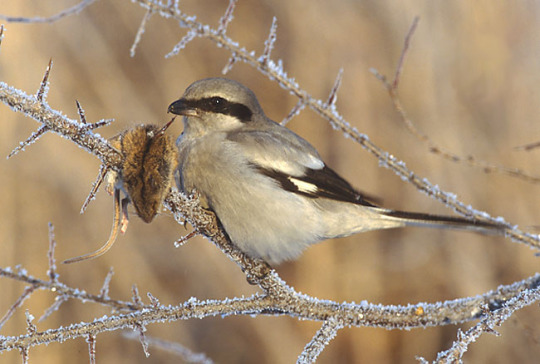
the entire family of shrikes is a motley collection of songbirds that have evolved sideways into carnivory- they'll kill and eat just about anything smaller than they are, which includes rodents like mice, smaller birds, and even reptiles like snakes and lizards!
which they then promptly impale on the closest sharp thing.
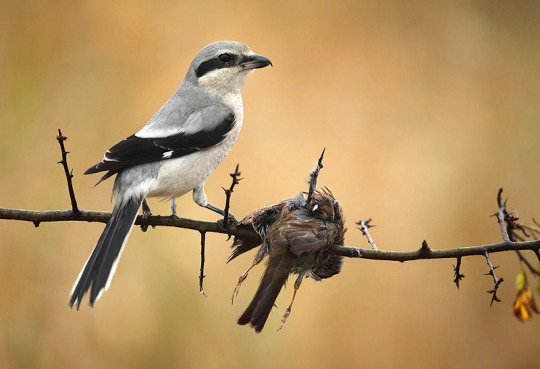
this war-crimey habit has earned them the name butcherbird across most of their range. the shrikes do this partly for storage (a shrike that is very good at shriking can have an entire thornbush full of tiny corpses!), but also because, well.
they've got the raptor beak down, but they haven't quite managed to figure out the talons yet.
sticking their prey in place keeps it still so that they can pull off chunks small enough to swallow!
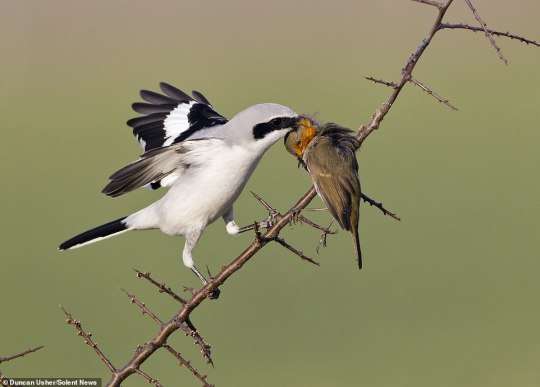
basically the same way humans use those fancy ham stands.
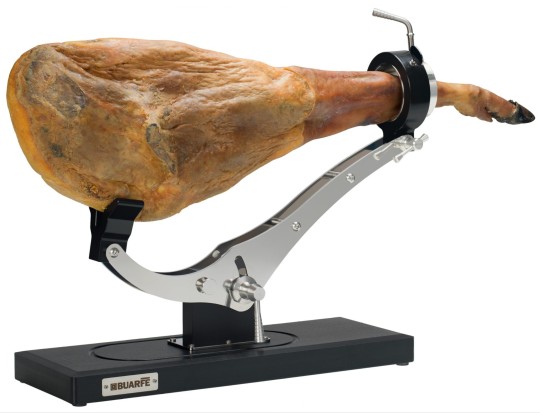
these things.
and now you know! here's a picture of one being silly to wash the taste of small animal death out of your mouth.
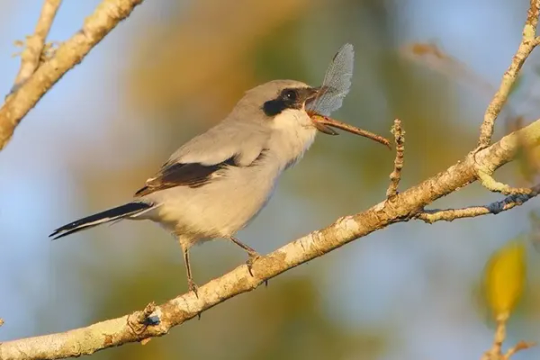
2K notes
·
View notes
Text
All round one results are in! Let's say congratulations to our winners, listed from widest to narrowest margin:
72.3 points: Snow Leopard, defeated Grey Butcherbird
68.3 points: Striped Skunk, defeated Australian Pelican
66.4 points: Piping Plover, defeated Keel-Billed Toucan
59.8 points: Black Footed Cat, defeated Barnacle Goose
58.7 points: Masked Lapwing, defeated Eastern Red Bat
58.1 points: Egyptian Fruit Bat, defeated American Bullfrog
53.9 points: Tawny Frogmouth, defeated Star-Nosed Mole
51.8 points: Sea Otter, defeated Australian Magpie
51.0 points: American Alligator, defeated Inchworm
50.5 points: Asian Elephant, defeated Silkworm
50.2 points: Southern Pudu, defeated American Black Bear
49.2 points: Least Weasel, defeated Crayfish
44.7 points: Mini Lop Rabbit, defeated Domestic Guinea Pig
42.9 points: Great Purple Emperor, defeated Pygmy Seahorse
42.2 points: Lesser Hedgehog Tenrec, defeated Tardigrade
42.2 points: White-Tailed Deer, defeated Dumbo Octopus
41.4 points: Pygmy Goat, defeated Arctic Tern
36.8 points: Veiled Chamaeleon, defeated Barn Owl
36.2 points: Leopard Gecko, defeated Orca
34.8 points: Harp Seal, defeated African Forest Buffalo
27.0 points: Spectacled Flying Fox, defeated Gerenuk
26.1 points: Ball Python, defeated Okapi
25.1 points: Wild Boar, defeated Red Fox
22.9 points: Killdeer, defeated English Shorthorn
18.4 points: Clouded Leopard, defeated Capybara
16.4 points: South American Coati, defeated Ribbon Eel
15.6 points: Spotted Hyena, defeated Platypus
15.4 points: Tree Swallow, defeated Wild Turkey
12.4 points: Orchid Mantis, defeated Pygmy Slow Loris
8.7 points: Fairy Penguin, defeated Pygmy Hippo
5.4 points: Giant Pacific Octopus, defeated Aardwolf
2.1 points: Australian Owlet-Nightjar, defeated Spectral Tarsier
I'm gonna take at least a day or two before queueing up round 2. Unless I receive overwhelming feedback otherwise, I will again use a random number generator for the matchups, and use the same graphics (with taxonomic info) for each animal. However,
#cute#animals#baby animals#bracket#tournament#tumblr tournament#poll#cute animals#poll blog#zoology#results
5 notes
·
View notes
Text
Great Backyard Bird Off - Schedule & Info
Round One Schedule
Cosmopolitan - posted February 1st & 2nd - 14 polls
Europe - posted February 11th - 9 polls
Africa - posted February 20th - 9 polls
Australia - posted March 1st & 2nd - 20 polls
New Zealand - posted March 11th - 7 polls
Asia - posted March 20th & 21st - 14 polls
the Americas - posted March 29th & 30th - 16 polls
Eurasia - posted April 8th & 9th - 14 polls
Poll Info
There are 8 brackets, with 208 species featured! Ranges were determined either using the self-report feature added to the submission box or with eBird sightings. "Cosmopolitan" is a bracket involving species of birds which were found on at least three continents, regardless of which they were submitted for. "Eurasia" are birds which seem to appear equally between Europe and Asia (majority of the continent, not just Middle East). "the Americas" includes all of the Americas, with US birds removed- granted, some Canadian or Mexican birds can show up in the US, but they're not common enough backyard birds (imo) to have been disqualified.
Please-- feel free to advocate for whichever bird you vote for! I would love to get some more participation with this tournament, especially since this is a poll with popular bird species.
Polls will be a week long, and are tagged #Great Backyard Bird Off. All subsequent reblogs are tagged as #poll reblog. Be sure to block this tag if you want to avoid me spamming your dash. Any reblogs containing support for a species will be tagged #[species] support. Results will be tagged #poll results.
Bird Support Google Form
vvv Participant List under the Read More vvv
Cosmopolitan (28 species)
Black kite, Black-headed gull, Bohemian waxwing, Canada goose, Common buzzard, C. Chiffchaff, C. Kingfisher, C. Loon, C. Myna, C. Nightingale, C. Swift, Eurasian Collared-dove, Eurasian Hoopoe, Eurasian (Common) Kestrel, Eurasian Tree Sparrow, European bee-eater, European (common) starling, Great crested grebe, Great gray owl, Grey wagtail, Little grebe, Ring-necked pheasant, Red-backed Shrike, Rock Pigeon, Rose-ringed Parakeet, Western barn owl, Western cattle egret, White (pied) wagtail
Europe (18 species)
Tawny Owl, Spotless Starling, Red kite, Middle spotted woodpecker, Great spotted woodpecker, Fieldfare, European Stonechat, E. Robin, E. Herring Gull, E. Goldfinch, Eurasian Green Woodpecker, Eurasian Golden Oriole, Eurasian blackcap, Eurasian (Common) Blackbird, Dunnock, Crested tit, Common wood-pigeon, Eurasian Blue tit
Africa (18 species)
African Harrier-hawk, Bearded barbet, Blacksmith lapwing, Bokmakierie, Cape starling, Cape white-eye, Dark-capped bulbul, Hadada ibis, House bunting, Klaas' Cuckoo, Kwevoel (Grey go-away-bird), Nile valley sunbird, Purple-crested turaco, Red-winged starling, Southern double-collared sunbird, Southern masked weaver, Spotted eagle-owl, White-backed mousebird
Australia (41 species)
Yellow Wattlebird, Willie-wagtail, White-faced Heron, Welcome Swallow, Weebill, Tawny Frogmouth, Tasmanian Nativehen, Superb Fairywren, Sulfur-crested Cockatoo, Splendid Fairywren, Sooty Owl, Red-browed Firetail, Red wattlebird, Rainbow lorikeet, Peid currawong, Pheasant coucal, Pacific koel, Noisy miner, Masked lapwing, Magpie-lark, Little corella, Lewin's honeyeater, Laughing kookaburra, Grey fantail, Grey butcherbird, Gang Gang cockatoo, Galah, Eastern spinebill, Eastern rosella, Crimson rosella, Crested pigeon, Crescent honeyeater, Bush stone curlew (thick-knee), Brown thornbill, Black swan, Bell miner, Austarlian ringneck, Australian magpie, Australian Ibis (Bin Chicken), Australasian Swamphen (Pukeko)
New Zealand (14 species)
Kaka, Kakaruwai (South Island robin), Karearea (NZ falcon), Kereru, Koekoea (Long-tailed Koel), Korimako (NZ bellbird), Yellowhead, Piwakawaka (NZ Fantail), Riroriro (Grey Gerygone), Satin Bowerbird, Silvereye (Tahou), Titipounamu (Rifleman), Tomtit, Tui
Asia (28 species)
Asian Koel, Azure-winged Magpie, Black-collared Starling, Brown-eared Bulbul, Colombo (House) Crow, Common Hill-myna, Eastern Buzzard, Japanese Robin, Light-vented Bulbul, Mandarin Duck, Masked Laughingthrush, Olive-backed Sunbird, Oriental Magpie-robin, Oriental Pied Hornbill, Palau Fruit dove, Palla's Gull, Purple-rumped Sunbird, Red-billed Blue magpie, Red Junglefowl, Red-whiskered bulbul, Ruppell's Weaver, Southern Hill-myna, Spotted dove, Swinhoe's White-eye, Whistling Green-pigeon, White-rumped munia, White-spectacled bulbul, Yellow bittern
The Americas (33 species)
Austral Thrush, Bananaquit, Blue-and-white Swallow, Blue-and-yellow Macaw, Bushy-crested Jay, Canada Jay, Chalk-browed Mockingbird, Chimango, Clay-colored Thrush, Common Potoo, Crimson-fronted Parakeet, Eared Dove, Great Kiskadee, Great Thrush, Green-backed Firecrown, Green-headed Tanager, Hoatzin, Lesson's Motmot, Masked Water Tyrant, Pacific Hornero, Pale-breasted Thrush, Plain Parakeet, Red-rumped Cacique, Ruddy Ground Dove, Rufous Hornero, Rufous-bellied Thrush, Rufous-collared Sparrow, Russet-naped Wood rail, Sayaca Tanager, Southern House Wren, Southern Lapwing, White Bellbird, White-crested Elaenia
Eurasia (28 Species)
Black Redstart, Blue Rock thrush, Carrion Crow, Coal Tit, Common Chaffinch, Eurasian Bullfinch, Eurasian Bittern, Eurasian Jackdaw, Eurasian Jay, Eurasian Magpie, Eurasian Nuthatch, Eurasian Oystercatcher, Eurasian Siskin, Eurasian Sparrowhawk, Eurasian Treecreeper, Eurasian Wren, European Greenfinch, Goldcrest, Great Tit, Hawfinch, Hooded Crow, Long-tailed Tit, Mistle Thrush, Northern Lapwing, Rook, Song Thrush, Spanish Sparrow, Yellowhammer
#great backyard bird off#poll info#tbf this post is as much for me as it is for yall#i just need to get better at planning bc of school and all#but I really love running this blog#hopefully this poll is big enough to carry us through most of the year!
28 notes
·
View notes
Photo

he Pied Butcherbird is a medium-sized black and white bird. It has a full black hood, dark brown eye and long, hooked, grey and black bill. It has a broad white collar that goes all around its neck and a black bib (throat area). The rest of the underparts are white and the legs are black. The upper parts are mostly black, with large patches of white on the wings and rump. In flight, the white corners of the otherwise black tail are easily seen
0 notes
Text
Houseboat stories…..After the Floods
Houseboat stories continued (May 2023)…..After the Floods Dear Reader: As I walk across the flood plain, which was inundated in last year’s winter rains, there is a definite lack of wildlife. Bushes, grasses and other ground covers have been decimated. Last time I visited this area there were: Butcherbirds, Mudlarks, parrots, honeyeaters, Western Grey Kangaroos as well as an abundance of…
View On WordPress
#Apple watch#Australian birds#Cabbage White#Kings Billabong#Nikon P900 camera#pink eared duck#South Australian tourism#south australian travel#South Australian wetlands#South Australian wildlife#spoonbill#water birds#Whistling Kite#wildlife photography
0 notes
Note
I for some reason didn't see the word shrike and assumed they were talking about the grey butcherbirds of Australia which is very DISTANTLY related to the shrikes on north America (Most well known of the shrikes are the Loggerhead and Northern shrike because they're actually the only species of shrikes that practice their odd form of storing prey) OH and also Butcherbirds are usually regarded as far more gruesome than shrikes due to the fact that after they store their prey on branches and such they'll just start to rip and tear into them before ditching it to store later OR to attract mates!!!! Though a loggerhead shrike would probably fit heart better (Maybe during a specific era though I dunno) because personality wise shrikes are very apathetic especially with courting behaviors and treating other birds, they also cannot sing at all! They sorta just, scream or let out a shrill, discordant call.
i think if heart was a bird he'd be a shrike
its even got the black band across its eyes.
its a passerine bird, sometimes called the "Butcher Bird" for impaling its prey on thorns and branches.
Oh! Shrikes are nice. Love those lil guys. I'm not like- any kind of bird-know it all but my Grandmother is VERY into birds and by proxy I wound up with a mild interest in em!
I think a shrike is probably a good bet.

Silly little birds aren't they?
#My bad I like birds a LOT#Its a huge interest of mine so lolol#cccc heart#cccc#chonnys charming chaos compendium
30 notes
·
View notes